
California contains the highest and lowest points in the entire country, with Mount Whitney as the highest peak outside Alaska and the Badwater Basin in Death Valley marking the lowest end.
©Doug Meek/Shutterstock.com
California, the third largest state in the United States, boasts impressive dimensions, spanning 560 miles from west to east and 1040 miles from north to south at its widest and longest points. A captivating mix of cliffs, beaches, volcanic lava beds, fertile river valleys, waterfalls, mountains, and deserts accentuates its diverse physical geography. Remarkably, it contains the highest and lowest points in the entire country, with Mount Whitney as the highest peak outside Alaska and the Badwater Basin in Death Valley marking the lowest end. These extremes locate just 85 miles apart.
California Statistics
California, situated on the Western coast of the United States, is a prominent state with a population of nearly 39.2 million residents spread over an expansive area of approximately 163,696 square miles (423,970 km2). It is the most populous state in the U.S. and ranks third in size. Remarkably, it also is the most densely populated sub-national entity in North America and the 34th most populous in the world. The state boasts two major urban regions, Greater Los Angeles, with over 18.7 million residents, and the San Francisco Bay area, home to more than 9.6 million people. Sacramento is the state’s capital, while Los Angeles is the most populous city and the second most populous city in the nation. San Francisco, on the other hand, holds the position of the second most densely populated major city in the country.
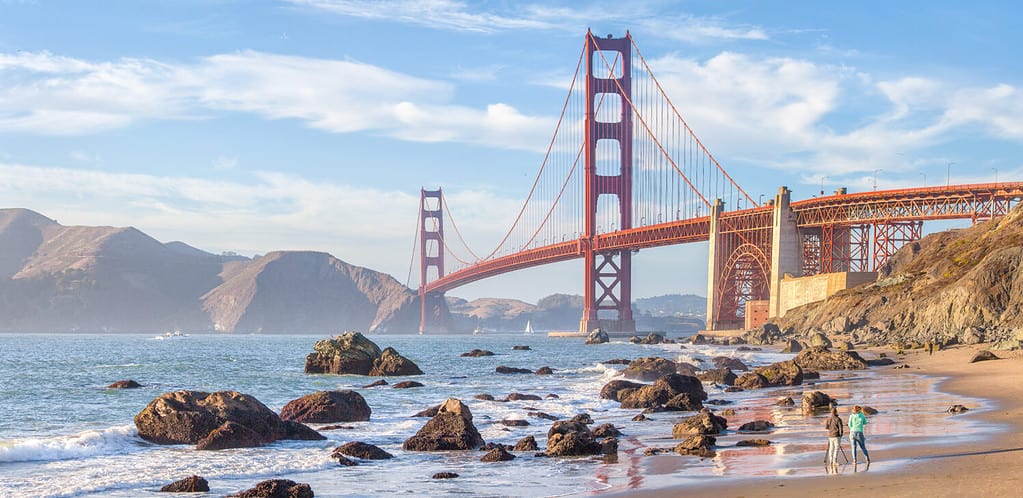
San Francisco holds the position of the second most densely populated major city in the country.
©canadastock/Shutterstock.com
The Coast
The California coastline along the Pacific Ocean is a breathtaking stretch, covering 840 miles. The southern section, between Santa Barbara and the Mexican border, is renowned for its stunning sandy beaches like Malibu, Venice, Santa Monica, and Huntington. Heading further north, the beaches become more spaced, with picturesque sandy shores like Carmel, Monterey Bay, and Santa Cruz on the Central Coast. The northern part features remote coves and rocky bluffs, providing excellent vantage points for whale-watching.
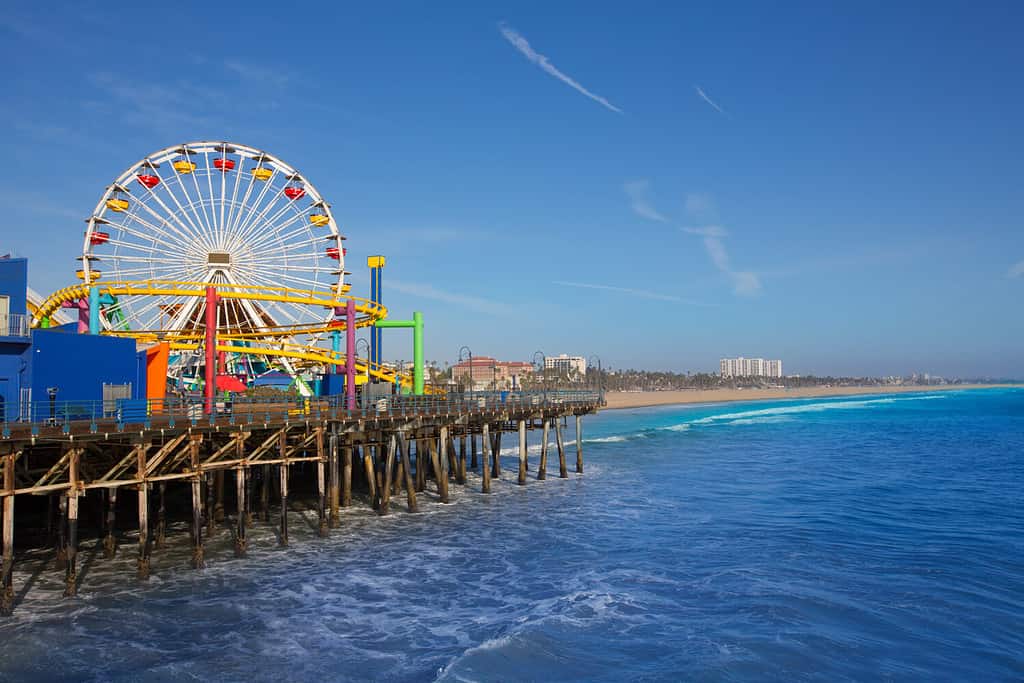
The California coastline along the Pacific Ocean is a breathtaking stretch, here is the beautiful Santa Monica pier.
©lunamarina/Shutterstock.com
The Mountains
Among the numerous mountain ranges in the state, the Sierra Nevada in eastern California stands out as the most significant and awe-inspiring. It hosts innumerable peaks soaring over 13,000 feet, with Mount Whitney being the highest at 14,505 feet and a popular target for climbing expeditions. The Sierra Nevada’s highest peaks remain snow-covered throughout the winter months. Notable ranges include the White Mountains and the Inyo Mountains, situated near the Nevada border, separated from the Sierra Nevada by Owens Valley. In Northern California, the volcanic peaks of Mount Shasta and Mount Lassen, located at the southern end of the Cascade Range, offer captivating scenery.
For winter sports enthusiasts, the San Bernardino Mountains to the east of Los Angeles provide ample opportunities, with reliable snowfalls every winter. The highest peak in this range is San Gorgonio Mountain, at 11,503 feet. In the Mojave Desert to the east of the San Bernardino range, Charleston Peak rises slightly higher at 11,916 feet. To the south, the San Jacinto, Santa Rosa, and Laguna Mountains complete the mountainous landscape.
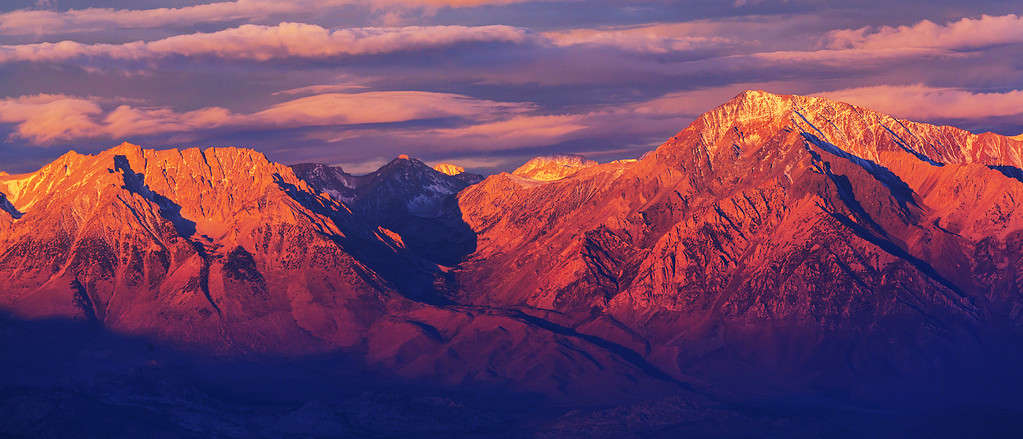
The Sierra Nevada’s highest peaks remain snow-covered throughout the winter months.
©Galyna Andrushko/Shutterstock.com
The Lower-lying mountains, including the California Coast Ranges, run along the Pacific coast, stretching over 400 miles from Humboldt County to Santa Barbara County and designated as a UNESCO Biosphere Reserve. The Transverse and Peninsular Ranges are south of these ranges, featuring peaks over 10,000 feet in elevation.
Rivers, Lakes, and Reservoirs
California’s primary rivers are the Sacramento and San Joaquin, with numerous tributaries flowing from the Sierra Nevada through the Sacramento and San Joaquin valleys to San Francisco Bay and eventually emptying into the Pacific Ocean. The Colorado River defines California’s border with Arizona.
The state boasts several significant freshwater lakes and reservoirs. Tahoe, situated on the California-Nevada border in the Sierra Nevada, is the largest by volume in the world. With a massive depth of 1644 feet and a length of 22 miles, its vastness hinders viewing one side from the other due to the Earth’s curvature. Other notable lakes include Clear on the Northern Coast and Lake Shasta in the Shasta Cascade. Additionally, California hosts saline lakes, such as Mono east of Yosemite, and the largest Californian lake, the Salton Sea in the Colorado Desert, which is renowned for birdwatching rather than swimming. Numerous smaller lakes dot the state’s landscape, adding to its natural splendor.
California Geography Essentials
California’s immense size is undeniable, surpassing many countries in land area. As the third largest state in the U.S., it stretches over three times the length of Greece and four times that of Iceland.
Careful planning is essential to explore a substantial part of California on a single trip. Its elongated outline spans nearly 900 miles, extending from the northern border with Oregon to the southern border with Mexico. A north-to-south drive can take around 15 hours, comparable to driving from New York City to Jacksonville, Florida. Even a cross-state drive from Santa Barbara to Needles covers 350 miles.
The vast distances are also evident within California’s metropolitan regions. Driving from San Francisco to Los Angeles takes nearly 400 miles and a full day. A theme park road trip from Universal Studios Hollywood to SeaWorld San Diego spans 125 miles while exploring Los Angeles and Orange County beaches involves approximately 90 miles between Malibu and Laguna Beach.
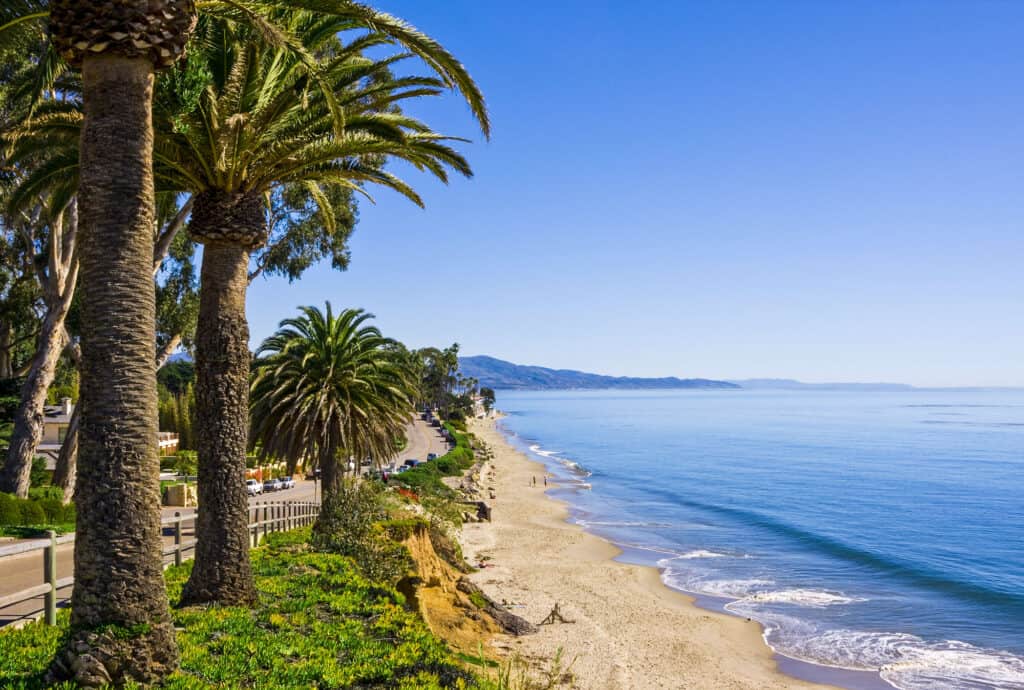
California offers swimming spots in coastal areas, lakes, rivers, and pools.
©iStock.com/DavidMSchrader
More Geography
For those eager to witness California’s majestic desert parks, a distance of 230 highway miles separates Death Valley’s stunning badlands from Joshua Tree’s remarkable rock formations.
California’s largest county, San Bernardino, encompasses over 20,000 square miles, surpassing the combined land area of Vermont and New Hampshire. In the state’s smaller counties, towns are often far apart in terms of distance and character. Sonoma Plaza, known for its artisan cafes and boutiques, lies 85 miles from the relaxed beach hamlet of Sea Ranch, where the coastal climate offers respite with temperatures 20 degrees cooler in the summer. Similarly, Inyo County experiences deep, powdery snow in Bishop’s high mountains, while 165 miles away, Furnace Creek bakes under a scorching desert sun.
Such diverse geography translates into a myriad of stunning landscapes. California boasts 840 miles of coastline, 25,000 square miles of desert, and snow-capped volcanoes. One can stand amidst the towering trees in the temperate rainforest of far northern California or visit North America’s hottest and driest point near the state’s eastern border. The Sierra Nevada Mountains, a 400-mile-long range of saw-toothed peaks, cradle Lake Tahoe, one of the world’s largest alpine lakes, and Mount Whitney, the highest mountain in the contiguous United States at 14,505 feet.
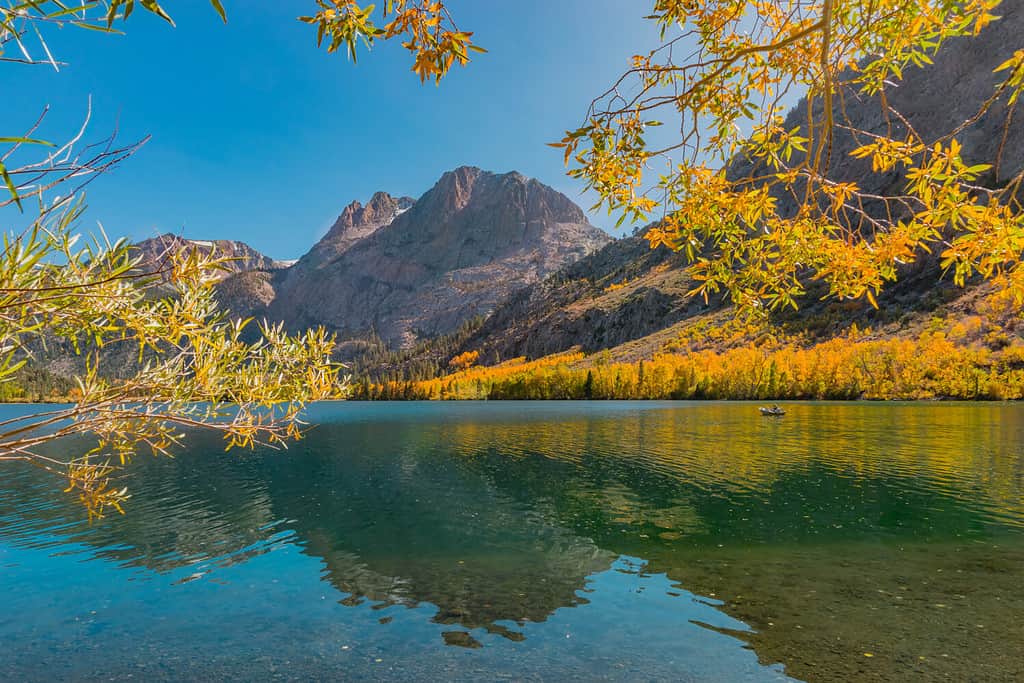
The Sierra Nevada Mountains, a 400-mile-long range of saw-toothed peaks, cradle Lake Tahoe, one of the world’s largest alpine lakes, and Mount Whitney, the highest mountain in the contiguous United States at 14,505 feet.
©Patricia Elaine Thomas/Shutterstock.com
California’s vastness and diversity demand ample time for exploration. Consider these approximate time and distance calculations when planning your next visit (travel times may vary).
Travel Times Between Cities
San Diego to Anaheim: 95 miles/153 km (2 hours)
San Diego to Los Angeles: 120 miles/193 km (2.5 hours)
Anaheim to Los Angeles: 27 miles/43 km (1 hour)
Los Angeles to Palm Springs: 105 miles/169 km (2 hours)
Los Angeles to Santa Barbara: 95 miles/153 km (2 hours)
Yosemite National Park to Sequoia National Park: 160 miles/258 km (4 hours)
Yosemite National Park to Death Valley National Park: 250 miles/403 km (5 hours)
Sacramento to Redding: 160 miles/258 km (2.5 hours)
Sacramento to San Francisco: 90 miles/145 km (2 hours)
San Francisco to Sonoma: 45 miles/72 km (1 hour)
Reno to San Francisco: 218 miles/351 km (4 hours)
San Francisco to Napa: 50 miles/ 80 km (1 hour)
San Francisco to Yosemite: 200 miles/322 km (3.5 hours)
California’s Twelve Regions
The state divided California into twelve distinct regions based on its diverse physical geography. While people categorize 58 counties as Northern and Southern California, the exact border is subject to debate. Generally, the people draw the line along the northern boundaries of San Luis Obispo, Kern, and San Bernardino counties, with everything south of it, considered Southern California and the remaining two-thirds of the state considered Northern California. Here are the twelve regions:
Shasta Cascade
Located in the far northeast, this region boasts volcanic mountains, lava beds, the expansive Shasta-Trinity National Forest, Shasta Lake, and sparkling rivers.
North Coast
Stretching from the Bay Area to the Oregon border, this coastal strip features rugged cliffs, rocky beaches, rolling green hills, and misty forests of giant redwood trees, including the renowned Avenue of the Giants. Small towns and communities dot the region exuding Victorian architecture and an environmentally-conscious, artistic vibe.
San Francisco Bay Area
Encompassing San Francisco, the cultural hub of Northern California, the East Bay cities of Oakland and Berkeley, and the Silicon Valley city of San José. To the north are the counties of Marin, Sonoma, and Napa, known for their open countryside, woodlands, and wineries, while to the south are San Mateo, Santa Cruz, and Santa Clara counties, offering a mix of farmland, affluent suburbs, and scenic coastal areas like Half Moon Bay.

Encompassing San Francisco, the cultural hub of Northern California, the East Bay cities of Oakland and Berkeley, and the Silicon Valley city of San José.
©Basil D Soufi, CC BY-SA 3.0, via Wikimedia Commons – License
Gold Country
Named after the historic Gold Rush of the 19th century, this region consists of charming mining towns, farms, wineries, and minor arts communities. The American River, a lively tributary of the Sacramento River, runs through this region.
High Sierra
Home to some of the state’s most breathtaking mountain landscapes, this region has been shaped by glaciers over millennia. It encompasses Lake Tahoe, Mono Lake, and iconic national parks such as Yosemite, Sequoia, and Kings Canyon.
Central Valley
Stretching from just north of Sacramento to Los Angeles, the flat and fertile Central Valley is a major agricultural region. Its rich soil supports the growth of many crops, including almonds, tomatoes, grapes, apricots, and asparagus, making it one of the world’s most productive agricultural areas.
Central Coast
Stretching from the San Francisco Bay Area to Santa Barbara, this region boasts a scenic coastline with highlights like Monterey and its broad bay, the breathtaking cliffs of Big Sur, and historic Mission communities. The Central Coast is known for its picturesque Winelands, including San Luis Obispo, Paso Robles, Edna Valley, and Santa Barbara County. Visitors can explore the charming Danish-built settlement of Solvang and the inviting beachside town of Santa Barbara. Five of the Channel Islands, located offshore, are also designated national parks.

View of Stearns wharf pier of Santa Barbara with Santa Ynez mountains and Pacific Ocean, Santa Barbara County, California.
©Tsuguliev/Shutterstock.com
Los Angeles County
This vibrant county is home to Los Angeles, California’s most populous and glamorous city. The city lies on a hilly desert plain between the Pacific Ocean and the forested San Gabriel Mountains, with the foothills of the Santa Monica Mountains to the northwest. Notable neighborhoods include Malibu, Beverly Hills, and Hollywood. The county’s coastline is adorned with beautiful beaches and boardwalks, while the picturesque island of Santa Catalina lies offshore. Beyond the vast grid of L.A.’s streets are the San Bernardino Mountains.

The city lies on a hilly desert plain between the Pacific Ocean and the forested San Gabriel Mountains, with the foothills of the Santa Monica Mountains to the northwest.
©Larry Gibson/Shutterstock.com
Orange County
Situated between San Diego, Los Angeles, and the Inland Empire, Orange County is a beachside paradise. Once known for its orange groves, it now features must-visit amusement parks, shopping centers, and resorts. Despite its relatively small size, Orange County is the most affluent county in Southern California.
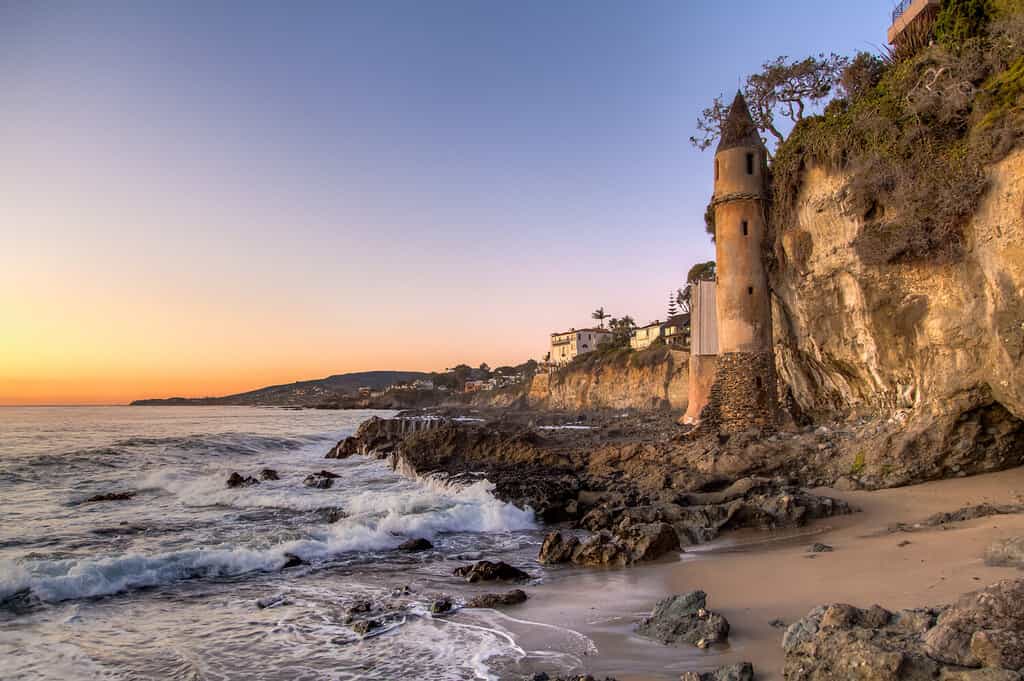
Beautiful coastline in Victoria Beach, Laguna Beach, Orange County, California.
©kan_khampanya/Shutterstock.com
Inland Empire
Positioned east of Los Angeles in California’s extreme southwest, adjacent to the Deserts region, the Inland Empire comprises suburbs that house much of the Los Angeles workforce. Further east lie the San Bernardino Mountains and National Forest, offering a scenic retreat from urban life.
The Deserts
Located in the state’s southeast, this vast region showcases arid plains, dunes, and mountains of unparalleled beauty. It has several impressive national parks, including Death Valley National Park, Mojave National Preserve, and Joshua Tree National Park. The heavily irrigated Coachella and Imperial Valleys and Anza-Borrego Desert State Park also grace this area. The elegant town of Palm Springs serves as the primary urban base for exploring the desert’s wonders.
San Diego County
Situated close to the Mexican border, San Diego is California’s second-largest metropolis, with a population half that of L.A. The city features hills and canyons, creating pockets of open space throughout the urban landscape. San Diego’s coastline offers long stretches of sandy beaches. At the same time, the eastern region is adorned with avocado farms, the thicket of Cleveland National Forest, and the grassy slopes of the Laguna Mountains.
California’s twelve regions collectively create a tapestry of natural beauty, cultural diversity, and vibrant urban centers, making the Golden State an unparalleled destination for visitors and residents alike.
California Fun Facts
California is often referred to as “The Golden State” due to the California Gold Rush of the mid-1800s, which attracted thousands of prospectors to seek their fortunes in gold.
With a population of nearly 40 million people, California is the most populous state in the United States.
California is the third-largest state by area, covering approximately 164,000 square miles (423,970 square kilometers). It boasts diverse geography, ranging from sandy beaches, mountains, forests, deserts, and fertile valleys.
California is the global center of the entertainment industry, particularly Hollywood, famous for producing movies, television shows, and music. The Hollywood Sign is an iconic landmark representing the state’s showbiz allure.
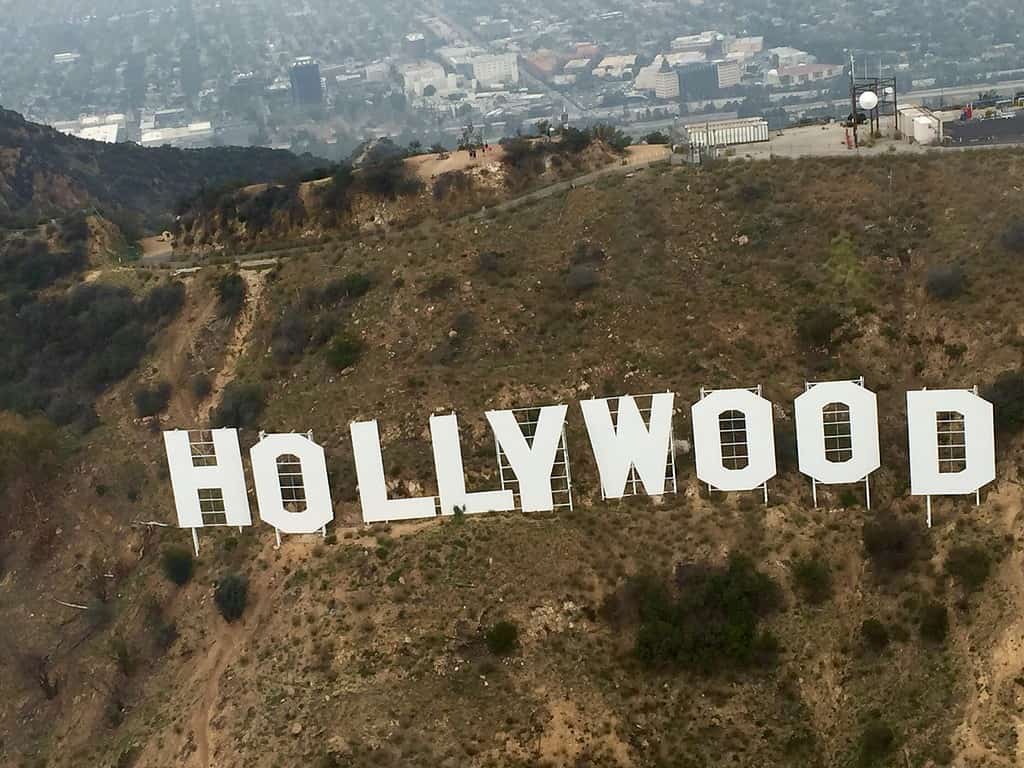
Hollywood sign as seen from a helicopter
©Jnellisnc / CC BY-SA 4.0 – License
Silicon Valley is the world’s leading technology and innovation hub in the southern part of the San Francisco Bay Area. It is home to numerous tech giants, startups, and research institutions.
California is a central wine-producing region in the United States known for its premium wines. The Napa and Sonoma Valleys are renowned wine regions, attracting wine enthusiasts worldwide.
The state is home to nine national parks, including iconic locations like Yosemite, Sequoia, Kings Canyon, and Joshua Tree, offering visitors breathtaking natural beauty and diverse landscapes.
California boasts several iconic landmarks, such as the Golden Gate Bridge in San Francisco, the
Hollywood Walk of Fame, Disneyland in Anaheim, and the iconic cable cars in San Francisco.
California is a leader in environmental initiatives and sustainability. The state has implemented various programs to promote renewable energy, reduce greenhouse gas emissions, and conserve natural resources.
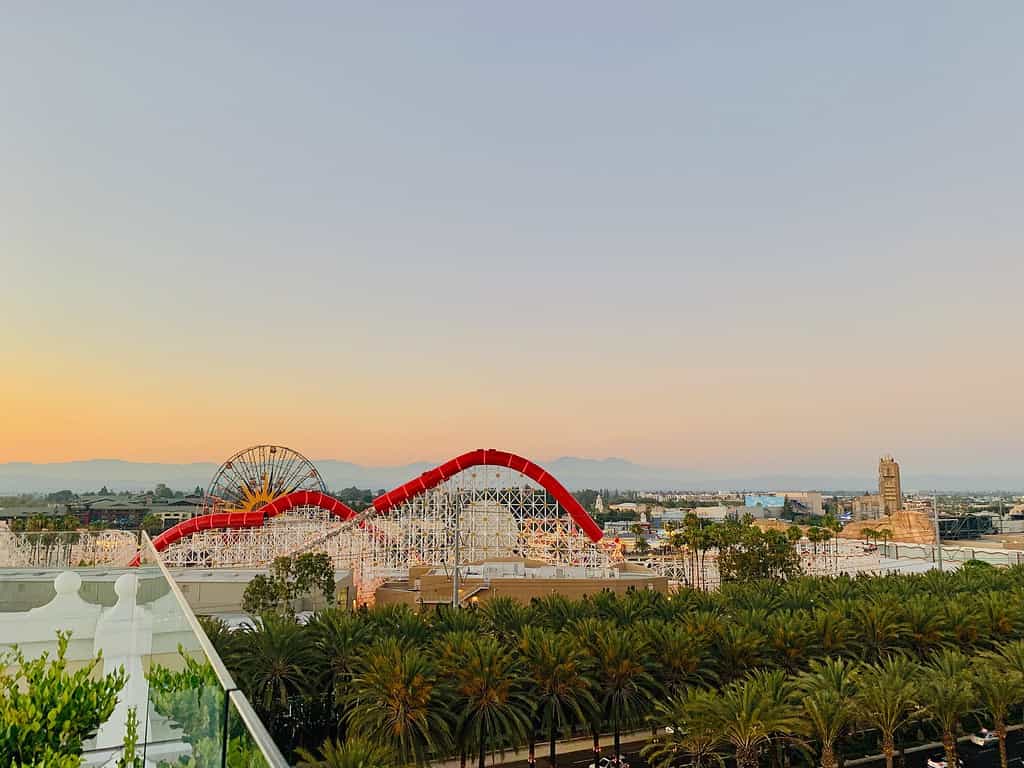
Disneyland in Anaheim, California.
©Glenn Taylor/Shutterstock.com
California is a major agricultural producer in the United States. It leads to the production of several crops, including almonds, strawberries, grapes, avocados, and pistachios.
More Fun Facts
California is home to Mount Whitney, the highest point in the contiguous United States, standing at 14,505 feet (4,421 meters). On the other hand, Death Valley, located in California, holds the record for the highest recorded temperature on Earth. It has been recorded as reaching 134 degrees Fahrenheit (56.7 degrees Celsius) in 1913.
California is one of the most culturally diverse states in the U.S. The state has a vibrant blend of ethnicities, languages, and traditions.
California is home to some of the largest and oldest trees in the world. The famous sequoia trees in Sequoia and Kings Canyon National Parks include General Sherman. It is considered the most giant tree on Earth by volume.
California experiences frequent seismic activity due to its Pacific Ring of Fire position. The San Andreas Fault is one of the state’s most well-known and active fault lines. It is responsible for significant earthquakes in the past.
California is synonymous with surfing culture, and the sport’s popularity skyrocketed in the state during the 1960s. Consequently, surfers flocked to iconic spots like Huntington Beach (nicknamed “Surf City, USA”) and Malibu to ride the waves year-round.
The state motto of California is “Eureka,” a Greek word meaning “I have found it.” This phrase became popular during the California Gold Rush when prospector James W. Marshall reportedly shouted “Eureka!” upon discovering gold in Coloma, California, in 1848.
California’s state flower is the California poppy (Eschscholzia californica). These vibrant orange wildflowers blanket hillsides during the spring, creating stunning landscapes and earning the nickname “California’s golden poppy.” It’s also illegal to pick them on state-owned land.
From its captivating natural landscapes to its influential impact on entertainment and technology, California remains an intriguing and dynamic state. It continues to leave a lasting impression on the world.
The photo featured at the top of this post is © Joseph Sohm/Shutterstock.com
Thank you for reading! Have some feedback for us? Contact the AZ Animals editorial team.






